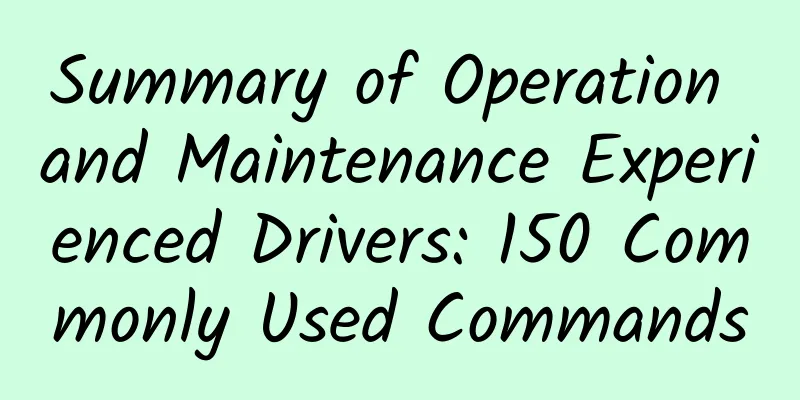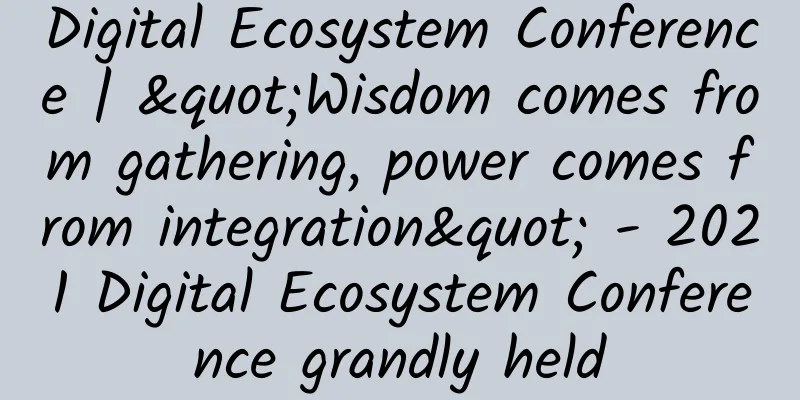|
When it comes to operation and maintenance, everyone always thinks of network repair. In fact, there is a lot of knowledge in network repair. Now let’s listen to a veteran operation and maintenance person’s summary of the 150 most commonly used commands in operation and maintenance projects. Online query and help commands (2) - man: View command help, command dictionary, and more complex info, but it is not commonly used.
- help: View the help of Linux built-in commands, such as the cd command.
File and directory operation commands (18 commands) - ls: The full spelling is list, which is used to list the contents of a directory and its content attribute information.
- cd: full spelling of change directory, its function is to switch from the current working directory to the specified working directory.
- cp: The full spelling is copy, and its function is to copy files or directories.
- find: means to search, used to find directories and files under them.
- mkdir: The full spelling of make directories, its function is to create directories.
- mv: The full spelling is move, and its function is to move or rename files.
- pwd: The full spelling of print working directory is to display the absolute path of the current working directory.
- rename: used to rename files.
- rm: The full spelling is remove, and its function is to delete one or more files or directories.
- rmdir: The full spelling is remove empty directories, which is used to delete empty directories.
- touch: Create a new empty file and change the timestamp attribute of an existing file.
- tree: The function is to display the contents of the directory in a tree structure.
- basename: Displays the file name or directory name.
- dirname: Displays the file or directory path.
- chattr: Change the extended attributes of a file.
- lsattr: View file extended attributes.
- file: Displays the file type.
- md5sum: Calculates and verifies the MD5 value of a file.
View file and content processing commands (21) - cat: The full spelling of concatenate is used to concatenate multiple files and print them to the screen or redirect them to a specified file.
- tactac: It is the reverse spelling of cat, so the function of the command is to display the file contents in reverse.
- more: Display the file contents in pages.
- less: Displays file contents in pages, the opposite of the more command.
- head: Displays the header of the file content.
- tail: Display the tail of the file content.
- cut: Split each line of the file into its own delimiter and output it.
- split: Split the file into different small parts.
- paste: merge file contents line by line.
- sort: Sort the text content of the file.
- uniq: remove duplicate lines. oldboy
- wc: Count the number of lines, words, or bytes in a file.
- iconv: Convert file encoding format.
- dos2unix: Convert DOS format files to UNIX format.
- diff: full spelling difference, compares the differences between files, commonly used for text files.
- vimdiff: A command-line visual file comparison tool, commonly used for text files.
- rev: Output file contents in reverse order.
- grep/egrep: filter string, the third of the Three Musketeers.
- join: merge two files based on the same fields.
- tr: Replace or delete characters.
- vi/vim: command line text editor.
File compression and decompression commands (4) - tar: package and compress. oldboy
- unzip: Decompress files.
- gzipgzip: compression tool.
- zip: compression tool.
Information display commands (11 commands) - uname: command to display operating system related information.
- hostname: Display or set the host name of the current system.
- dmesg: Displays boot information and is used to diagnose system failures.
- uptime: Displays system uptime and load.
- stat: Displays the status of a file or file system.
- du: Calculate disk space usage.
- df: Reports the disk space usage of the file system.
- top: Displays system resource usage in real time.
- free: View system memory.
- date: Display and set system time.
- cal: View calendar and other time information.
Search file commands (4) - which: Search for binary commands according to the path of the environment variable PATH.
- find: Search the disk for files or directories.
- whereis: Search for binary commands based on the path of the environment variable PATH.
- locate: Search commands from the database (/var/lib/mlocate/mlocate.db) and use updatedb to update the library.
User management commands (10) Oldboy - useradd: Add a user.
- usermod: Modify the properties of existing users in the system.
- userdel: delete a user.
- groupadd: Add a user group.
- passwd: Change the user password.
- chage: change the validity period of the user password.
- id: View the user's uid, gid and the user group to which he belongs.
- su: switch user identity.
- visudo: A dedicated command for editing the /etc/sudoers file.
- sudo: Execute commands previously allowed in the sudoers file as another user (default root user).
Basic network operation commands (11) Old Boy - telnet: Remote login using the TELNET protocol.
- ssh: remote login using the SSH encryption protocol.
- scp: abbreviated as secure copy, used to copy files between different hosts.
- wget: command line to download files.
- ping: Tests the network connectivity between hosts.
- route: Display and set the routing table of the Linux system.
- ifconfig: Command to view, configure, enable or disable network interfaces.
- ifup: Start the network card.
- ifdown: shut down the network card.
- netstat: View network status.
- ss: Check the network status.
In-depth network operation commands (9 commands) - nmap: network scanning command.
- lsof: The full name is list open files, which means listing the files that have been opened in the system.
- mail: Send and receive mail.
- mutt: Mail management command.
- nslookup: A command for interactively querying Internet DNS servers.
- dig: Find the DNS resolution process.
- host: command to query DNS.
- traceroute: traces the data transmission route.
- tcpdump: command line packet capture tool.
Disk and file system related commands (16) - mount: Mount the file system.
- umount: Unmount the file system.
- fsck: Check and repair Linux file systems.
- dd: Convert or copy files.
- dumpe2fs: Export ext2/ext3/ext4 file system information.
- dumpe: xt2/3/4 file system backup tool.
- fdisk: disk partition command, suitable for disk partitions below 2TB.
- parted: A disk partitioning command with no disk size limit, commonly used for partitioning disks below 2TB.
- mkfs: Format and create a Linux file system.
- partprobe: Updates the kernel's hard disk partition table information.
- e2fsck: Checks ext2/ext3/ext4 type file systems.
- mkswap: Create a Linux swap partition.
- swapon: Enable swap partition.
- swapoff: Turn off the swap partition.
- sync: Write the data in the memory buffer to disk.
- resize2fs: resize ext2/ext3/ext4 file system.
System permissions and user authorization related commands (4) - chmod: Change file or directory permissions.
- chown: Change the owner and group of a file or directory.
- chgrp: Change the file user group.
- umask: Display or set the permission mask.
View system user login information commands (7) - whoami: Displays the current valid user name, which is equivalent to executing the id -un command.
- who: Displays information about users currently logged into the system.
- w: Display a list of users who have logged into the system and the commands that the users are executing.
- last: Displays users logged into the system.
- lastlog: Displays the most recent login information of all users in the system.
- users: Displays a user list of all users currently logged into the system.
- finger: Find and display user information.
Built-in commands and others (19 commands) - echo: print variables, or directly output the specified string
- printf: Format the results and output them to standard output.
- rpm: command for managing rpm packages.
- yum: A command that automates and simplifies the management of rpm packages.
- watch: Periodically executes a given command and displays the command output in full screen mode.
- alias: Set the system alias.
- unalias: Cancel the system alias.
- date: View or set the system time.
- clear: Clear the screen, also known as clear screen for short.
- history: View the history of command execution.
- eject: Eject the CD-ROM drive.
- time: Calculates the command execution time.
- nc: Powerful network tool.
- xargs: Convert standard input into command line arguments.
- exec: A command that calls and executes instructions.
- export: Set or display environment variables.
- unset: Delete a variable or function.
- type: Used to determine whether another command is a built-in command.
- bc: Command-line Scientific Calculator
System management and performance monitoring commands (9 commands) - chkconfig: manage Linux system startup items.
- vmstat: virtual memory statistics.
- mpstat: Displays the status statistics of each available CPU.
- iostat: Statistics of system IO.
- sar: Comprehensively obtains system performance data such as CPU, run queue, disk I/O, paging (swap area), memory, CPU interrupts and network.
- ipcs: Used to report the status of inter-process communication facilities in Linux. The displayed information includes message lists, shared memory, and semaphore information.
- ipcrm: Used to delete one or more message queues, semaphore sets, or shared memory identifiers.
- strace: A Linux user space tracer used for diagnosis and debugging. We use it to monitor the interaction between user space processes and the kernel, such as system calls, signal transmission, process state changes, etc.
- ltrace: The command will trace the library function calls of the process, and it will show which library function is called.
Commands for shutting down/restarting/logging out and viewing system information (6 commands) - shutdown: shut down the computer.
- halt: shut down the computer.
- poweroff: Turn off the power.
- logout: Exit the currently logged-in shell.
- exit: Exit the currently logged in shell.
- Ctrl+d: Shortcut key to exit the currently logged-in Shell.
Process management related commands (15) - bg: Change a command that is paused in the background to continue execution (execution in the background).
- fg: Bring the command in the background to the foreground to continue running.
- jobs: Check how many commands are currently running in the background.
- kill: Terminate the process.
- killall: Terminate a process by its process name.
- pkill: Terminate a process by its process name.
- crontab: scheduled task command.
- ps: Displays a snapshot of the process.
- pstree: Display processes in tree format.
- nice/renice: adjust the priority of program execution.
- nohup: Run the specified command ignoring hangup signals.
- pgrep: Search for processes matching a condition.
- runlevel: View the current run level of the system.
- init: Switch the run level.
- service: Start, stop, restart, and shut down system services, and display the current status of all system services.
|










![[11.11] CMIVPS annual promotion VPS host 50% off, Hong Kong large bandwidth/direct line monthly payment starts from US$3.5](/upload/images/67cac23863b4e.webp)